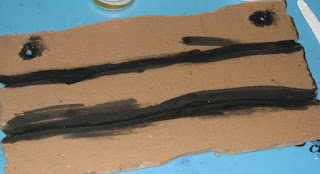Today I wanted to share a bit about how I made the Springtime Welcome sign I shared with you yesterday.
As I mentioned at the time just about everything you see started out as just paper or chipboard. Now I'll tell you how I did it...
I started off by die-cutting LOTS of petals out of smooth white Club Scrap cardstock...lots and lots and lots. I did cut a few yellow bases from some scraps I had left over from another project...they won't be seen in the finished flower so it's o.k. they are a different color.
I used several different dies to make the flowers - the Dahlia was made using a combination of petals from the Sunflower (5 bottom layers) and Tiny Daisy (2 center layers + layer wrapped around a bead) dies. In addition to these dies I used a few Spellbinder flower dies as well. Some of these flowers were cut out of colored Club Scrap cardstock - deep pink, yellow and a few different greens for the leaves and other foliage.
After all of the petals were cut I colored each petal (or leaf) with PanPastels. The Dahlia was colored with a couple different shades of purple for the outer petals, as the layers of petals got closer to the center I started using darker and darker shades. Some of the inner tiny petals were colored on both sides because their curl was deep enough that you could see both sides.
Here is how each layer was assembled - each layer has 8 petals. There are 3 layers or the largest petal, 2 layers of the medium size petal and 7 layers of the really tiny petal. I also used a plastic pony bead for the very center of the dahlia. There were a couple layers of beads which were colored on the back side with the PanPastels; shaped & curled very tightly, then glued directly to the bead.
I repeated these steps for the rest of the flowers. I also applied PanPastels and shaped each of the leaves and bits of foliage as well. Most of the flowers have pips, beads or micro beads glued in their centers. Assembling the flowers and all of the foliage took most of a weekend.
Next I started on the sign it's self...I pulled out a piece of book board (really thick chipboard) that was left over from another project.... It was already the basic size and shape I needed so that was a plus!
I wanted the board to resemble a wood sign so I pulled out my Exacto knife and started carving the edges and spaces between the "boards".
The edges and spaces were painted with Lamp Black paint.
A thick layer of Deco Art Crackle Paste was applied to the boards. Remember - thicker layers produce larger cracks once cured. I also drew a few lines through the medium to mimic the striations you might find on weathered wood boards.
Here are a couple photos of the crackle medium as it dries...
I left it to dry over night....
The next morning the Crackle Paste had completely dried and I was left with lovely crackle finish. I applied a coat of Renaissance Brown Elegant Finish Metallic Glaze. I know what you're thinkin' - that sounds pretty fussy for an old wood board. Nope, this stuff is great! It's got a rich shimmer chocolate look and once it's applied over the white crackle paste it creates a beautiful finish.
Since it's a glaze (which is a bit thinner and translucent) and not an acrylic paint the crackle finish is very visible once dry.
I then stamped "welcome" with some foam stamps and more black acrylic paint.
I determined where I wanted everything to go and started gluing it down. I filled in the design with a few tiny Prima flowers here and there and then tied on the ribbon for hanging.
So there you go...
Spring Welcome sign ready to greet our visitors!
Hope you enjoyed the process.
Supplies:
ClubScrap.com - Cardstock, Book Board, Ribbon
DecoArt - Crackle Paste, Americana Lamp Black Paint, Elegant Finish Metallic Glaze - Renaissance Brown
Spellbinders - Flower & Leaf Dies
Sizzix - Flower Dies
PanPastels
Glue, Micro Beads, Beads, Pips, Foam Tape, Letter Stamps



















This is so cool, Roni!! A beautiful welcome sign for your door. Love the faux wood substrate! I'll have to have a go at making one. Have a wonderful week. Hugs
ReplyDeleteRoni, this is gorgeous! When I saw the photo I thought it was real wood. That crackle paste is a wonderful substitute for weathered wood and your hand colored flowers are perfection!
ReplyDelete